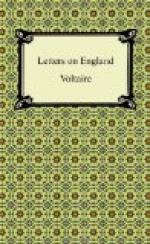From what cause, therefore, do colours arise in Nature? It is nothing but the disposition of bodies to reflect the rays of a certain order and to absorb all the rest.
What, then, is this secret disposition? Sir Isaac Newton demonstrates that it is nothing more than the density of the small constituent particles of which a body is composed. And how is this reflection performed? It was supposed to arise from the rebounding of the rays, in the same manner as a ball on the surface of a solid body. But this is a mistake, for Sir Isaac taught the astonished philosophers that bodies are opaque for no other reason but because their pores are large, that light reflects on our eyes from the very bosom of those pores, that the smaller the pores of a body are the more such a body is transparent. Thus paper, which reflects the light when dry, transmits it when oiled, because the oil, by filling its pores, makes them much smaller.
It is there that examining the vast porosity of bodies, every particle having its pores, and every particle of those particles having its own, he shows we are not certain that there is a cubic inch of solid matter in the universe, so far are we from conceiving what matter is. Having thus divided, as it were, light into its elements, and carried the sagacity of his discoveries so far as to prove the method of distinguishing compound colours from such as are primitive, he shows that these elementary rays, separated by the prism, are ranged in their order for no other reason but because they are refracted in that very order; and it is this property (unknown till he discovered it) of breaking or splitting in this proportion; it is this unequal refraction of rays, this power of refracting the red less than the orange colour, &c., which he calls the different refrangibility. The most reflexible rays are the most refrangible, and from hence he evinces that the same power is the cause both of the reflection and refraction of light.




